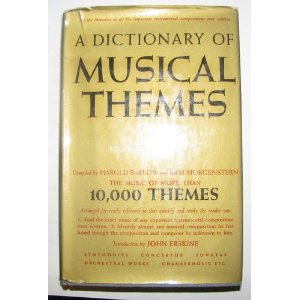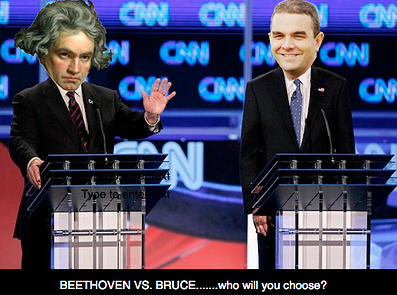Blog
Monthly Archive: October 2012
Have all the good melodies already been used up?
Posted on Sunday, October 21, 2012
For some reason I feel the urge today to answer this perennial question: Have all the good melodies already been used up? To answer it I will have to delve into a little very light mathematics and also reveal a potentially billion-dollar idea I've had for many years.
Start by comparing a melody to the moves in a game of chess. One of the reasons chess is so popular is that after only a very few moves, the possibilities of what could have happened have become so vast that they allow for a near infinite amount of combinations.
Let's take the most basic aspect of a melody - whether each note goes up, down, or stays the same compared with its predecessor. Comparing this one aspect after just twelve notes you've already reached over half a million possibilities. This was the thinking behind a great book I discovered in my school library many years ago, the Dictionary of Musical Themes

This book lists over 10,000 popular melodies using a code U for up D for down and S for stays the same. All you need to do is think of this melody contour for your piece (eg *SUSUSDDSDSDSD for Twinkle Twinkle Little Star) and the chances are you will find it in the book.
Now the reality of melodies is you actually have 12 possible notes (more if you count octaves of course though I can't think off hand of a famous melody than includes a span greater than an octave - please post in the comments if you think of one). With 12 options, it only takes 6 notes to get to 2,985,984 possibilites.
But we've forgotten something - rhythm. It's hard to quantify exactly how many different rhythms you could have for each note of your melody. Even if we stick to 'rational' rhythms it's a bare minimum of 16 (anything from a semiquaver through to a semibreve). If we just stick to that we have 16*12 possibilities for one note. That means just three little notes have a staggering 7,077,888 possibilities. And a 6 note melody (which is still pretty short) could have 50,096,498,540,544 possibilities!
But that's not even the end of it. Not counting all the other rhythmic possibilities we could add, of which simple triplets would be by far the most common; not counting all the ways notes can be ornamented or embellished - of which there are countless; we haven't even thought about harmony. And harmony is one of the great hidden secrets of melody. Many of your favourite tunes will be your favourite not just because of the notes themselves, but because of the way the harmony moves beneath them, giving some notes a satisfying 'soft-landing' or a deliciously unexpected sense of arrival. You only have to think of the famous One Note Samba to realise how important harmony is to melody.
So lets ultra-conservately add 8 more harmony options per note which gives us 1536 options per note. Our 6 note melody now yields 13,132,496,513,412,366,336 options. Which is probably enough to make even most chess players slightly daunted.
Now to that billion-pound idea.
If we go back the Dictionary of Musical Themes, I realised that if you were to add in a similar component for the rhythmic contour of a melody - three options, shorter, longer or stays the same, you could combine this with the Up-Down-Same pitch contour to come up with a 'code' for each melody where each note would be one of 3x3=9 options. We would start by encoding every melody into a string of characters (they could just be numbers 1-9) based on this. Then all you need is the technology to recognise whether someone is whistling/singing a note longer or shorter, higher or lower accurately, and within only a very few notes you could accurately know which song they meant. If you could create an iphone app that did this well I promise you you wouldn't be that far off the billion pound mark.
Being an entrepreneurial type I did actually try to set something like this up a few years ago, in a website I called tunespotting.org There are three very difficult problems to overcome. One is to accurately convert all the melodies in the world into this code. The second is to accurately convert someone's tone-deaf and inaccurate hum/whistle into the correct contour. And the third is to match the two resulting 'strings'. Given that there are some amazing 'loose-match' string searching programs out there, the third of these already exists; and also given things like the amazing Melodyne program which does a pretty good job of separating out indivual notes from an audio file, I really believe the technology already exists to make this a reality and for somebody to make a lot of money from it. It would take a lot of time and effort to get it working smoothly however, and, much to my dad's chagrin, I seem to prefer spending my time exploring just some of those 13,132,496,513,412,366,336 possibilties.
Foot in the door
Posted on Friday, October 12, 2012
It's nice when pieces start to take on a life of their own. I recently received an email from a member of Hartt Music School's Foot in the Door ensemble, saying he'd enjoyed Steampunk at a recent performance by Hudson Valley Chamber Winds and was even happier that his own group had decided to program the piece in their concert this October 17th. I hadn't even heard about the Hudson Valley performance, so this was a double delight. Having repeat performances through word of mouth alone is such a thrill and an honour - you know the performance is happening for no other reason than because the group wants it to happen! Have a great concert guys!
Update
It turns out the Atlantic Chamber Ensemble are also giving another performance of Steampunk this Saturday 20th in Richmond VA. Always a group to add a splash of fun and colour to a concert, the election-themed concert is billed as 'Bruce vs Beethoven' and the audience gets to vote! I'm not sure I fancy my chances there!

ACE are also performing Gumboots next year in collaboration with Amaranth Contemporary Dance which is the first time this dance-inspired piece will have been actually accompany dance.

